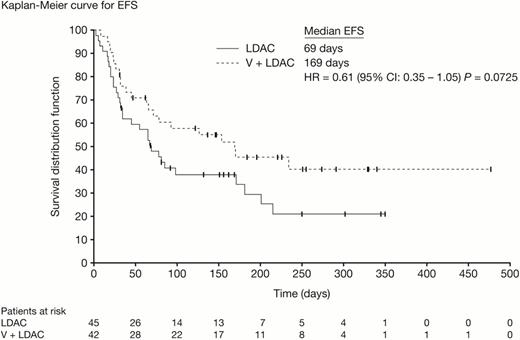Abstract
Abstract 411
LDAC is an established treatment option for patients (pts) with AML considered ineligible for intensive remission induction treatment. However, the outlook for pts who receive LDAC remains unsatisfactory, and novel therapeutic strategies are needed to improve clinical outcome in these pts.
Plk1 plays a key role in mitosis and cell cycle progression and is an attractive target for novel therapeutic approaches in cancer. Volasertib (V) is a first-in-class, selective and potent cell cycle kinase inhibitor that induces mitotic arrest and apoptosis by targeting Plks. The phase I part of this trial determined the maximum tolerated dose of V in combination with LDAC (V + LDAC) to be 350 mg and demonstrated antileukemic activity of V and V + LDAC in pts with relapsed/refractory AML ineligible for intensive therapy (Bug et al, ASH 2010 and 2011). Here we present preliminary phase II data for the randomized comparison of V + LDAC vs LDAC in pts with newly diagnosed AML ineligible for intensive treatment.
In the phase II part of this open-label study, eligible pts were randomized to receive V (350 mg 1-hr intravenously, days 1, 15 Q4W) + LDAC (20 mg bid subcutaneously, days 1–10 Q4W), or LDAC alone until progression/relapse or intolerance. The primary endpoint was objective response (complete remission [CR] or CR with incomplete blood count recovery [CRi]); secondary endpoints included event-free survival (EFS), overall survival (OS), safety and pharmacokinetics (PK).
87 pts were treated with V + LDAC (n=42) or LDAC (n=45). Pt characteristics (V + LDAC/LDAC) were largely balanced: median age, 75/76 yrs; secondary AML, 40.5%/64.4%; adverse cytogenetic group, 35.7%/33.3%. At time of analysis (February 22 2012) 15 pts were still on treatment (12 with V + LDAC). Pts received a median (range) of 2 (1–12) cycles of V + LDAC and 2 (1–11) cycles with LDAC.
A significantly greater proportion of pts who received V + LDAC achieved a CR or CRi compared with pts who received LDAC (31.0% vs 11.1%; odds ratio 3.59 [95% CI: 1.15, 11.18]; P = 0.0277), with a median (range) time to remission of 71 (29–158) days and 69 (34–125) days, respectively. Remissions with V + LDAC were observed across genetic groups, including pts with adverse cytogenetics.
A trend for longer median EFS was observed for pts who received V + LDAC compared with those who received LDAC (HR 0.61 [95% CI: 0.35, 1.05]; P = 0.0725; Figure). Follow-up for OS was ongoing at the time of this analysis. Among pts achieving CR/CRi, only 2 had experienced recurrence or death at the time of analysis (1 in each arm after a remission duration of 57 [V + LDAC] or 67 [LDAC] days). For all other pts ongoing in remission, the remission duration was censored after 53–407 days (LDAC + V) or 32–282 days (LDAC), consistent with prolonged duration of remission in some pts.
The most frequent all grade adverse events (AEs) in the V + LDAC arm were febrile neutropenia (50%), constipation (45.2%), nausea (40.5%) and anemia (40.5%). In the LDAC arm, the most common all grade AEs were nausea (33.3%), anemia (28.9%), pyrexia (28.9%), and constipation, asthenia and diarrhea (26.7% each). More pts who received V + LDAC experienced ≥ grade 3 AEs than those who received LDAC (95.2% vs 68.9%), particularly for blood and lymphatic system disorders (81.0% vs 44.4%), gastrointestinal disorders (21.4% vs 6.7%), and infections and infestations (45.2% vs 22.2%). The early death rates (V + LDAC/LDAC) at 30, 60 and 90 days were comparable between the two treatment arms: 30 days, 9.5%/8.9%; 60 days, 21.5%/17.8%; 90 days, 28.9%/33.4% (rates calculated using Kaplan-Meier method).
PK analyses demonstrated that V is a moderate clearance drug with multi-compartmental PK behavior, a large volume of distribution and a long terminal half-life. Preliminary data suggest no drug-drug interactions following combination of V with LDAC.
These preliminary phase II data demonstrate a significantly improved CR/CRi rate and a trend for EFS benefit with V + LDAC compared with LDAC alone in pts with newly diagnosed AML ineligible for intensive treatment. An increased frequency of AEs was observed with the addition of V, which was expected given its myelosuppressive mechanism of action; available data do not suggest increased early mortality for V + LDAC vs LDAC. A confirmatory phase III trial is needed to determine the clinical benefit of V + LDAC in pts with AML ineligible for intensive treatment.
Off Label Use: Volasertib is an investigational agent. Fiedler:Pfizer, Novartis: Membership on an entity's Board of Directors or advisory committees, Research Funding. Bug:Boehringer Ingelheim: Honoraria, Membership on an entity's Board of Directors or advisory committees. Müller-Tidow:Boehringer Ingelheim: Research Funding. Voss:Boehringer Ingelheim: Employment. Taube:Boehringer Ingelheim: Employment. Fritsch:Boehringer-Ingelheim: Employment. Döhner:Celgene, Amgen, Ambit, Astellas, Lilly: Consultancy.
Author notes
Asterisk with author names denotes non-ASH members.


This feature is available to Subscribers Only
Sign In or Create an Account Close Modal